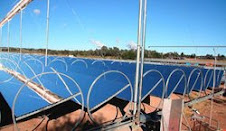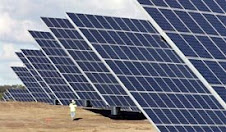Renewable Energy in America: the Policies for Phase II
by Michael Eckhart, President American Council on Renewable Energy
Washington, D.C. The American Council On Renewable Energy (ACORE) and over 35 Supporting Organizations are calling for new national goals and a public policy framework called "Phase II" for Renewable Energy in America. Decades of research and development have provided the technologies to move renewables foward. It's time to move on to Phase II: a major deployment phase for these technologies.
Historical Achievement: Phase I
Phase I is defined as the 30 year period from about 1973 to 2002, starting with the original oil embargo and energy crisis. During this period, the US federal government invested $99.2 billion dollars in energy research, development and demonstration (RD&D), including $49.1 billion for nuclear power, $24.8 billion for fossil fuels, $14.2 billion for renewable energy, and $11.1 billion for energy efficiency (Source: Congressional Research Service).
The $14.2 billion dollars of investment in renewable energy RD&D included programs for solar heating & cooling, solar thermal-electric, solar photovoltaics (PV), wind power, geothermal energy and power, hydropower (river and ocean), and biomass (bioenergy, biofuels and bioproducts), plus related investments in power systems, energy storage, and other areas.
The United States' investment in renewable energy technology was a government program success. It has achieved the original goal of creating technology options. Today, we see an initial round of commercially-available and economically-viable technologies in every renewable energy category, ready for widespread deployment, continued improvement, and further cost reduction through continuing R&D and technology transfer programs.
Looking Forward: Phase II
In December 2004, ACORE and the Phase II Supporting Organizations convened a policy forum entitled "The Call for Phase II" to ask the renewable energy community: has Phase I been successful, and are we ready for a Phase II? The answer, from all of the reports we gathered on technology and market readiness, was a resounding "yes." The Phase II coalition then turned to the question, what would a Phase II look like? Or, more specifically: "What are the national policies that will result in renewable energy contributing 20% - 30% - 40% of national energy supply by 2020 - 2030 - 2040?"
This presented a new policy challenge, breaking away from decades of thinking about developing new technologies, overcoming institutional barriers to commercialization, and creating initial demand to drive down costs through volume manufacturing.
But how to break out of the mindset we have been in for so long? How to change our lexicon from "a tax credit to help spur initial demand so that we can drive down the cost curve" to something like "fair tax treatment and policies in proportion to the public benefits that are generated by renewable energy?"
In an effort to find answers, ACORE held regional policy roundtable meetings in Austin, Boston, Chicago, Los Angeles, Phoenix, Portland, Raleigh, Sacramento, San Diego, San Francisco, Worcester, Mass and Washington, DC during July and August 2005. The meetings brought together 20 to 40 experts on renewable energy technologies, economics, applications, industry, regulation, and policy. In total, over 300 experts participated in the series. The findings were stunning -raising questions such as:
- Would the U.S. be a higher or lower taxed society if renewable energy increases? The answer appears to be "lower" and should be analyzed carefully as a new rationale for support.
- How would electric utility decision makers see renewable energy options differently if all utilities were required to offer customers 5-,10-, and 20- year fixed rates?
- How much more would it cost Detroit to produce all vehicles with flex fuel capability? Some say that the answer is "zero". This would allow every American to purchase biofuels wherever available.
- What are the current government incentives for consumers to purchase more efficient cars and/or biofuels? Some would say "none" because the current incentives are directed at the suppliers, not the consumers. How could we have missed this, for all these years?
- What would happen if we had to get a building permit not to put a solar system on our new houses? This is raises very basic questions about why we have permitting to begin with.
- What is the "natural geography" of strategies that will put renewable energy into widespread use in America - national, multi-state regional, state, sub-state regional, or local? The consensus seems to be that the natural boundaries for renewable energy markets are regional, not matching the lines of political jurisdictions. The implication is that there is a need for collaboration between levels of government.
- Which government incentive for renewable energy would Wall Street prefer? A 30% subsidy on initial cost of the systems? A 20-year assurance of project revenues? A loan guarantee program? If, as some believe, Wall Street wants reasonable assurance of revenues, then this suggests a shift from cost-based incentives in Phase I to performance-based incentives in Phase II.
- Do we have the mechanisms to monetize full value of the environmental benefits of renewable energy? The answer is, of course, no, and we need to work diligently towards this outcome.
We found no silver bullet in Phase II -- no single answer or philosophy that will win the day. The vastness of our country, the very regional nature of the resources, and the patchwork of political jurisdictions all point to a national strategy that first of all accommodates the diversity of opportunities and issues.
Indeed, the shift from Phase I, the relatively simple funding of RD&D through traditional government funding mechanisms, to Phase II, where policy must accommodate the breadth of differences across a huge nation, will be a great challenge, and worth our best efforts.
These any other challenges will be addressed at "Renewable Energy in America: the Policies for Phase II" will take place October 17-18, 2005 in the Cannon Caucus Room on Capitol Hill in Washington, DC. There will be plenary sessions of leading speakers, workshops for attendees to talk with speakers about policy strategies, and networking receptions. All are invited to pre-register and participate.
About the Author
Michael Eckhart is president of the American Council on Renewable Energy. He is also president of Solar International Management, Inc. (SIM) and sponsor of the SolarBank Program. He has over 25 years of experience in energy, power generation, high technology, and renewable energy, and is widely recognized for his recent work in the financing of solar energy in the U.S., Europe, Japan, India, and Africa. He has held management positions as the CEO of United Power Systems, Inc., Vice President of Arete Ventures, Inc., Manager of strategic planning for the Power Systems Sector of the General Electric Company, and Principal of Booz, Allen & Hamilton, Inc.. Mr. Eckhart is a member of the Chairmen.s Committee of the World Council for Renewable Energy (WCRE).
Article from RenewableEnergyAccess.com
blogs
Blogging
alternative energy
renewable energy
solar power
books
ecology
environment
Best Green Stocks Investing Blog
Subscribe to:
Post Comments (Atom)
Yuya Joe Blog
Lake Ontario Waterkeeper
The Daily Beast -Politics Blog
21stArch.com - 21st Century Architecture
Original Joe College Blog
WikiLeaks Foreign Policy Analysis
AGreenRealtor.com Real Estate Blog - Ecology Energy Efficiency
Best Green Stocks Investing Blog
PV Intell Photovoltaic Solar Stocks Investing
SEARCH Leading Alternative Energy and Ethical Investing websites

Custom Search
Daily Kos
Rare Earth Stocks Research
Patrick MacManus's Blog Peace and Collaborative Development
BeesTreesFrogsElephants.com - Nature and Ecology Blog
Research Green Energy stocks, Clean Energy investing information
Find wind power investing info online, clean energy mutual funds, geothermal stocks, solar energy investments.

Green Energy Investing Network:
Green Stocks Investing Clean Power Blog
SolarIntell.com Renewable Power Investing Website
Wind Intell.com Wind Energy Stocks Company Links
Geothermal Power Investing Public Companies
PV Intell.com Leading Photovoltaic Solar Energy Stocks

Custom Search
Green Energy Investing Network:
Green Stocks Investing Clean Power Blog
SolarIntell.com Renewable Power Investing Website
Wind Intell.com Wind Energy Stocks Company Links
Geothermal Power Investing Public Companies
PV Intell.com Leading Photovoltaic Solar Energy Stocks







No comments:
Post a Comment